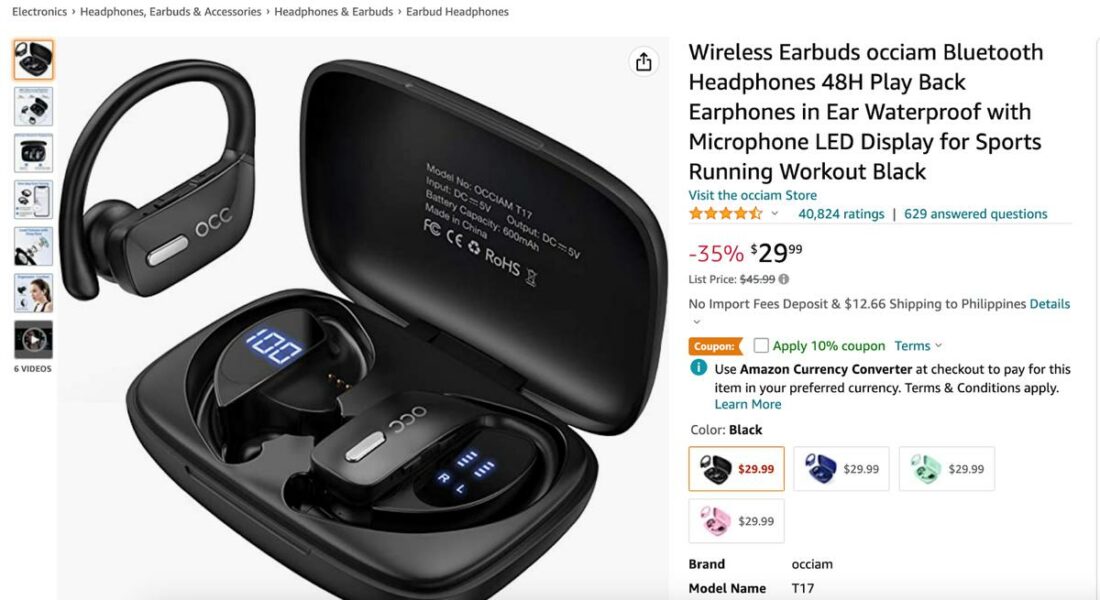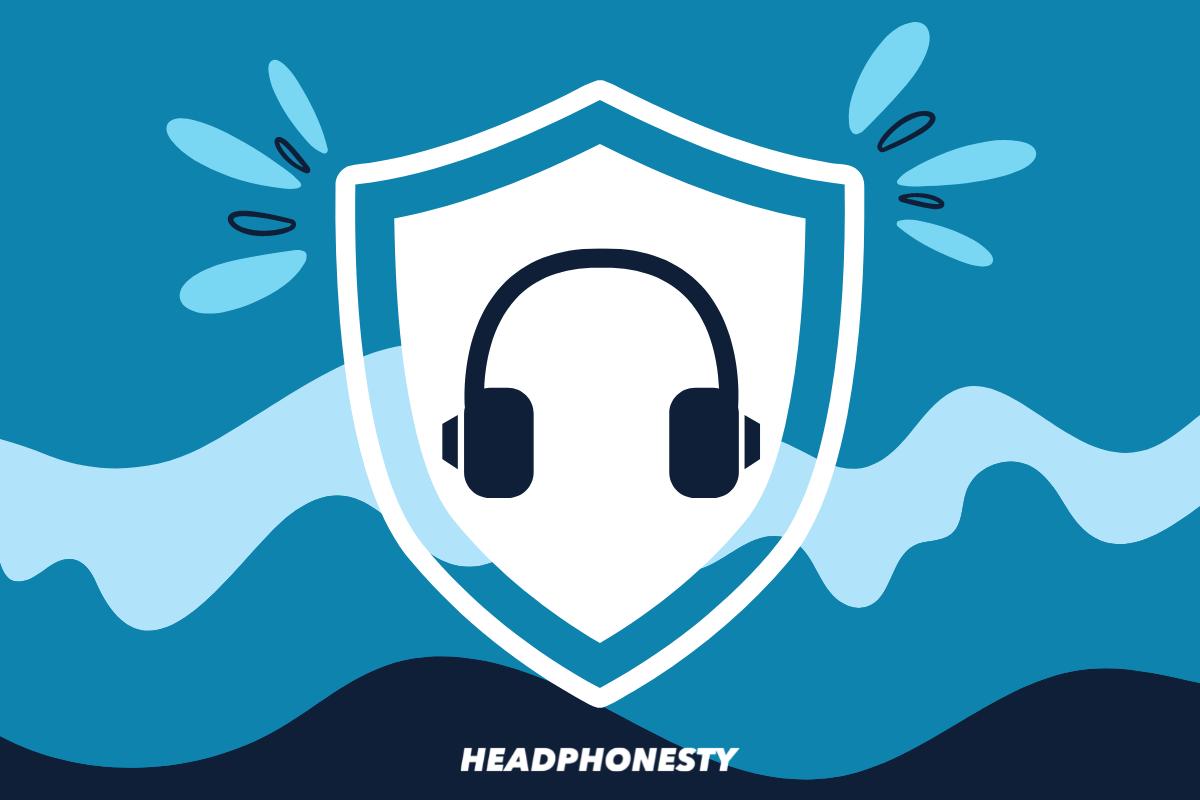Water-resistant, waterproof, water-repellent, weatherproof…. Here’s what all these terms really mean for your headphones.
Let’s say you enjoy jogging every morning or swimming while listening to music. So, you look for headphones that will help you achieve that. But while browsing, you’re faced with confusing terms like water-resistant, waterproof, water-repellent, and weatherproof.
Unfortunately, not understanding these terms can be more than just frustrating. Each term has a water exposure limit, and going beyond that can result in broken headphones or even electric shocks.
This article explains all these terms and how they impact your headphones so you can comfortably make a purchase that suits your needs. Ready? Read on!
Water-Resistant and Waterproof Headphones: Are They the Same?
Water-resistant and waterproof headphones are not the same. Water resistant headphones can withstand waer, but only at a certain level, angle, and time of exposure. Waterproof headphones, on the other hand, can be submerged completely.
It’s understandably easy to see why people use the two words interchangeably, though. Besides, that’s all you see on gadgets today!
Take the Occiam Bluetooth Headphones, for instance. According to the Amazon product name, these Occiam headphones are waterproof.

With this claim, they should be able to withstand water at all depths. But take a deeper read into the product specs, and you’ll find that this product name is somewhat misleading.
The Occiam headphones have an IP rating of IPX5 – not enough to be waterproof but rather water-resistant. We know it’s getting technical; we’ll explain everything later!
Sadly, these waterproof claims are only marketing schemes designed to hook you in for the buy.
To save you from getting fooled, it’s best to understand what these terms mean to differentiate them better.
What Is “Water-Resistant”?
If you have water-resistant headphones, it means they can hold off gently pouring water without damage. However, you cannot submerge them in water.
Water-resistant devices are designed tightly to keep water out of their system. Some are even using special substances (nano-coats) that prevent water from slipping into their system.
But, these nano-coatings have limited protection from water exposure, and they come in varying qualities. Some headphones are strictly sweat-resistant, while others can withstand high water pressure levels.
What Is “Waterproof”?
Waterproof headphones are the real deal – they work perfectly even when submerged under water. This is because they have a tight-knit hydrophobic coating that prevents water from entering the headphones.
However, you’d think waterproof headphones can survive in any situation, but that’s not the case.
Even though you can submerge waterproof headphones in water, they still have limits on how deep they can go. For example, headphones like the JBL UA True Wireless Flash X earphones can be submerged in water but not beyond 1 meter.
Check out waterproof headphones on our guide to the best headphones for swimming!
What Is “Water-Repellent”?
The term water-repellent isn’t commonly used for headphones, but the concept of water-repellency is simple.
Aside from thin-film nanotechnology like those of water-resistant headphones, these headphones are covered with a special durable water repellent (DWR). As a result, they’re not easily penetrable by water.
This cover allows water to simply bead on without penetrating the material for a long time.
But there’s a tradeoff when companies go with water-repellent materials. Water repellency may provide extra protection, but it also makes a material less breathable, which can lead to overheating. That’s why it’s not commonly used in headphones.
Now, the question remains, which type of headphones do you own or want? Waterproof or water-resistant headphones?
How to Know if the Headphones Are Water-Resistant or Waterproof?
The best way to tell if you have water-resistant or waterproof headphones is through the IP rating.
IP rating stands for Ingress Protection rating. It is a standard measurement for how effective an electrical enclosure is at resisting environmental conditions like dust and water. It also gives consumers more insights into the products – exactly why the International Electromechanical Commission (IEC) designed them. How?
Instead of using vague marketing terms like “waterproof” and “dust-resistant” to describe electronics, the IP rating helps consumers tell just how much water or dust their devices can take.
For example, if you have headphones with an IP rating of IPX7, you’ll know that you can submerge them for 30 minutes in over 3 ft of water.
Thankfully, you can easily tell the rating of your headphones as it’s usually written on the spec column of your headphones’ packaging. It’s written as IP with either an X and a number or a two-digit number. For example, IPX5 or IP54.
The minimum IP rating you should check for when you want to get headphones is IPX4. This means you’ll get headphones that can withstand splashing water (like sweat and light raing) for over 10 minutes without a problem. An example of headphones like these are the Sony WF-1000XM4.
If you want completely waterproof headphones, however, you want to get ones with a rating of IPX8, like the Sony NW-WS413LM or something with an IPX9K. These headphones can withstand continuous submersion of more than 1 meter.
Water-resistant headphones have an IP rating of IPX4 to IPX6. Ratings below that do not have enough protection, even to withstand sweat. Waterproof headphones, on the other hand, have an IPX7 to IPX9 rating.
Weatherproof vs. Waterproof: What’s the Difference?
Waterproof headphones repel water completely, and weatherproof headphones repel, well, the weather. Weatherproof headphones are those designed to withstand the elements, aging, and deterioration – for example, the Pyle Sports AZPWBH18WT. They’re essentially abrasion resistant.
Beyond water resistance, any headphones’ weatherproofing capabilities depend on their operating temperatures. Take the AirPods, for instance.
According to Apple, the AirPods can only withstand temperatures between 0º and 35º C (32º to 95º F).
While there’s a certain appeal to using your headphones whenever and wherever you want, you need to consider the effects on durability.
For instance, if your headphones are not built to survive in scorching environments, like the AirPods, using them in very hot conditions can shorten their battery life. Your AirPods may even start turning off on their own.
Conclusion
If you’re yet to get yourself some headphones, it’s time to think about the type you want. More importantly, you need to think about how you will use your headphones a lot of the time. Essentially, what activities would you undertake with your headphones?
You don’t need waterproof headphones if you’re just going for regular jogs. Get water-resistant headphones, and you’ll be good to go. But if you take dives with your headphones on, get waterproof headphones.
Sometimes, it doesn’t have to be one thing or the other.
Hopefully, this article clearly explained water-resistant, waterproof, water-repellent, and weatherproof headphones for you.
Time to go, but before that, we’d love to know your experiences with these headphones. Be sure to share them in the comments below.
